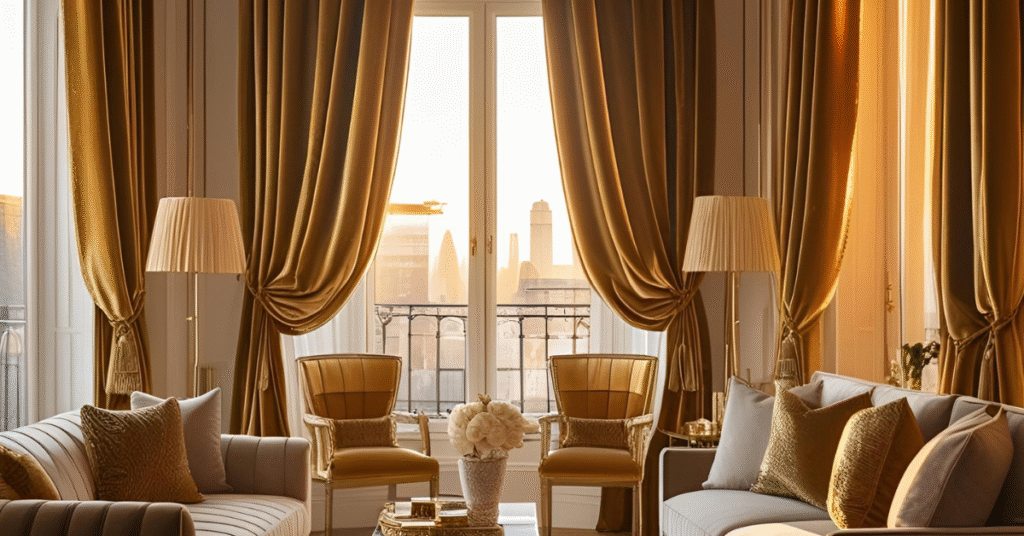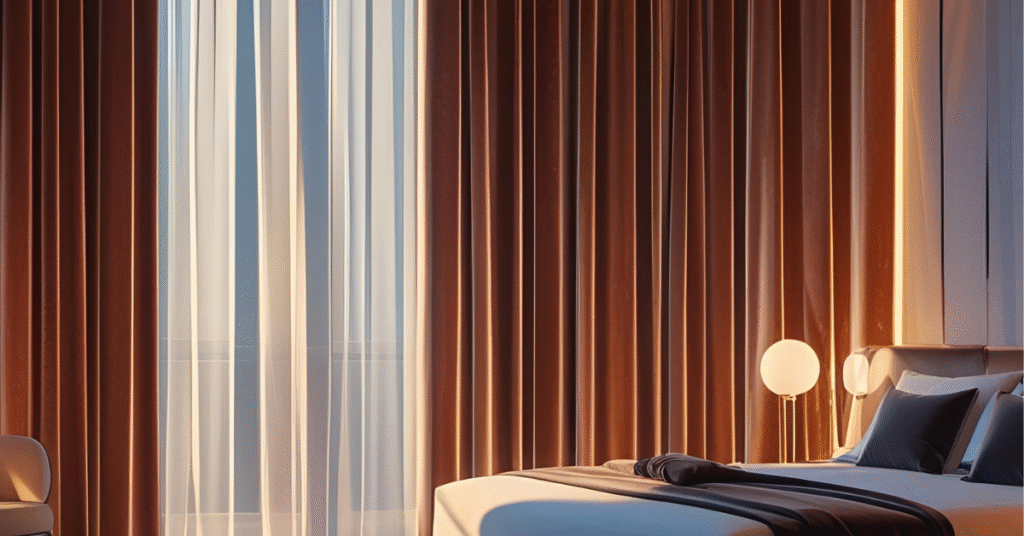Introduction: As any home designer knows, decorating a small room isn’t just designing; it’s a puzzle that requires precision. Each item must be meticulously selected, and every corner must be utilized fully. While mirrors and light colors have long been go-to choices for enlarging spaces, interior designers are now revealing the unexpected allure of velvet curtains. Not only does it block light, but with its rich texture and dramatic demeanor, a velvet curtain does wonders by pulling off stylish high-end makeovers for cramped interiors
This article highlights how expert designers masterfully utilize velvet curtains to bring out elegance, depth, and give the illusion of expensive value even in the smallest spaces without putting a strain on one’s budget.
Why Velvet Curtains Are The Designer’s Favorite Fabrics
The Texture of Luxury
Velvet is a type of fabric long associated with luxury and extravagance. It is used in home furnishings, especially as curtains, as it gives unmistakable sophistication. What makes velvet unique is the surface’s soft and plush tactile feeling, which elevates the visual appeal of a room. In compact spaces where furniture and accessories are kept to a bare minimum, a space becomes warm and rich when velvet curtains are introduced as design elements. Unlike lighter fabrics, designers prefer using velvet because it instantly transforms the atmosphere into something rich, providing warmth, making even basic window treatments look custom-designed
Light Reflection and Depth
Velvet fabric reflects light differently compared to flat fabrics because it has a dense pile that captures light at different angles. The light shimmer helps in creating an illusion of depth and movement on the curtain’s surface. In small rooms, one’s eye is inevitably drawn to the starkness of flat walls and uniform lighting, which can make a space feel boxy and stagnant. However, when you add a velvet curtain, it includes dynamic texture, making the room appear more layered than it is.
Interior designers love this effect because it gently softens layering while adding dimension to the room. It’s an important design tactic when working with tight quarters, intended to evoke elegance: Changing the perception of height or width creates a serene environment.
How Velvet Curtains Make Small Spaces Look Bigger

Drawing Eyes Upward
One of the most effective methods interior designers use to enhance the appearance of a small room is the use of vertical lines. Hanging velvet curtains from floor to ceiling creates strong vertical emphasis and draws the eye upwards, elongating the walls and giving an illusion of taller ceilings. Even in rooms with low or standard height ceilings, mounting the curtain rod a few inches below the ceiling and allowing the velvet drape to touch the floor transforms how spacious a room feels. The fabric’s natural weight assists in falling softly, which accentuates this vertical illusion further.
Soften Windows and Harsh Architectural Lines for Tight Spaces
Small rooms battling with an acute angle asymmetrical layout will have a boxy, rigid architectural styling that lacks visual interest. One can use various soft interior accent pieces to introduce movement and gentle drape – a plush velvet curtain does so best. With this space, the square windows and walls (which are typically harsh) will be complemented with softened lines through weaving. This technique is best in situations where the overall room has visual stiffness, like small spaces filled with wood, metal, or leather furniture.
Color Psychology and Fabric Choice
Stylish Velvet Curtain Colors for Small Apartments

In small apartments, the perception of space with the right color velvet curtain may be accentuated or completely neutralized. For drama and depth without making the room feel stuffy, interior designers often recommend jewel-toned velvets like emerald herbage, deep cortege, or burgundy. These colors strike a balance by absorbing enough light to feel cozy while still reflecting enough to prevent dullness. If spaciousness is intended, soft pink, ivory, soft gray, or champagne gold are ideal as curtains since these colors are further lighter and luxurious visually.
These shades make additional light available while providing velvet’s sumptuous texture. Contrivers not only match velvet curtain color to walls but also take cabinetwork, flooring, and even artwork into consideration to create balance that enhances spaciousness subtly. Designers don’t only use. A case in point is pairing curtains against other furnishings, which results in an elegant impression of unity difference when mismatched, such as dark walls kwa chafu light curtains.
Conversely, tone-on-tone color schemes like fine rose velvet curtains paired with warm neutral walls create a gentle, unified visual impression and enhance a small space’s perception of size. The selection of materials can be important for spatial perception as well.
Not all velvets are the same — some are cotton-grounded and matte, while others are synthetic with a further reflective luster. Designers often choose the velvet type based on the room’s illumination; for example, a strikingly bright velvet in dimly lit spaces serves to illuminate, or matte velvets serve in bright areas to dim light. The right combination of hue and fabric finish determines whether or not the velvet curtains will match and harmoniously enhance one’s elegance and spatial perception of a room.
Placement and Interior Design Stylist Smart Tricks
Mounting High and Wide
Using a velvet curtain transforms the style of an interior space in terms of how you plan to hang it. Most designers prefer the “mounting high and wide” technique where the rod is mounted just under ceiling near the window. Extending the
rod beyond the width of the window creates a taller grand illusion which is good on perception. With rich folds of velvet curtains, even small rooms appear elegant and spacious while softly reflecting light which in real terms gives an impression room is much more bigger than its original size. With this set up, rooms maintain a comfy setting without compromising elegance.
A velvet curtain has the added benefit of natural elegance and structural poise when suspended higher. When paired with smaller rooms, where every ounce of light is critical, extending the rod in width also enhances the room’s vertical perception while still preventing the curtain from blocking light. This technique not only adds balance between form and function but also leverages both style and space optimization.
Functionality through Sheers or Blinds
An extra layer of sophistication can be coupled with a functional blind by layering sheer panels under a velvet curtain, which many designers love to do. While controlling light and adding privacy, layering visually enriches the window area. In compact spaces where every inch matters, layering provides added depth without being cumbersome.
As mentioned earlier, sheer curtains create a plush feel as well as soften harsh sunlight, while pairing with a heavy velvet curtain approaches that of lavish hotel drapery. The result feels deliberately curated rather than chaotic cluttering. To preserve elegance and cohesion, designers often suggest neutral sheers with darker velvet or tone-on-tone combinations. The combination creates an illusion of depth, somewhat vital to small interiors wanting to appear more expensive through carefully chosen design principles.
Budget vs. Boutique: How to Get the Style You Want Without Overspending
Where to Purchase Velvet Curtains at a Reasonable Price
The look of velvet curtains can be extravagant, but their cost can now be relatively affordable. Designers have started looking for online sellers and retail shops that sell good-quality velvet drapes for much lower than the price of custom-made versions. A wide variety of dome stores and even fast fashion furniture brands offer ready-made velvet curtain panels in rich colors and designer-inspired finishes.
High-end items do not need to have expensive prices. Accessories, as well as branded names, are not what make velvet curtains look upscale. Instead, it stems from the weight of the fabric, fullness of pleats, and the curtain’s hanging position. Designers always suggest looking for heavier or lined options since they fall more elegantly and insulate better while blocking light effectively. A simple way to look tailored without needing a tailor is investing in longer panels and hemming them after reaching the desired height, attached to the ceiling.
DIY Tricks to Improve Off-the-Shelf Velvet Curtains
With the right touches, even off-the-shelf velvet curtains can be transformed. Designers know how to add custom details without breaking the bank, like using gold piping or velvet tiebacks as trims. These modifications add a decorative touch and make the curtains feel tailored to your space. Another option is adding necessary weighted hems so that the curtain hangs well and won’t look limp.
Velvet drapes also need steaming to remove any creases as well as shape them into smooth folds to help with light reflection. After installation, handheld steamers are best so that sprays are directed at specific areas while supporting proper fall of material for optimal light refraction. Pairing these hand-steamed velvet drapes with heavy rods made of metal greatly improves structural strength greatly improves final looks too. With these simple steps, adjustable velvet drapes can mimic luxurious draperies and give an illusion of expensive tailoring done by professionals, making any small room look sophisticated and carefully decorated.
Live Room Transformations & Designer Sayings
Prior and Posterior: Little Space Cleanups
The transformative power of velvet curtains is best showcased with real-world transformations. In small studio compact apartments or tightly spaced bedrooms, the use of velvet curtains creates a perceptual and atmospheric shift; thus, the before-and-after visuals are well justified to be placed alongside each other regarding perception alteration as well as atmosphere alteration during an adaptive approach towards flexible living spaces.
Consider one case where there is a studio living room that has plain walls and basic window blinds. Employing deep navy velvet curtains brings an instant elevation to the anchored feel of the space by giving it height. The rich folds of fabric break monotony while simultaneously adding sheen, thus enhancing dimension, making it feel upscale instead of utilitarian. Another case would be soft pink velvet curtains added onto narrow guest bedrooms, bringing lightness while still maintaining elegance, balanced perfectly in terms of proportions for the room.
Such transformations show that simple aesthetic touches with curtains can have an impact beyond style. Designers showcase such impacts to clients looking for singular move changes without a full rethink, redesign, remodel strikeout approach towards spatial design restructures.
Thoughts From Other Experts on Interior Design
Some interior designers consider the velvet curtain to be one of the most effective, yet underappreciated, small space design secrets. As noted by interior designer Clara Matthews, “velvet curtains give you drama, texture, and light control all in one element…and that’s incredibly valuable when you have limited square footage to work with.”
Another professional, Marcus Devereux, explains: “Clients are always surprised by how a simple velvet curtain can make their room feel taller, warmer, and more expensive. It’s about more than just function — it’s about feel.”
These insights unveil a truth many homeowners come to realize: velvet curtains transform ‘small’ into something far greater – a functional and stylish space augmentation while effortlessly blending luxurious design principles into cozy spaces.
